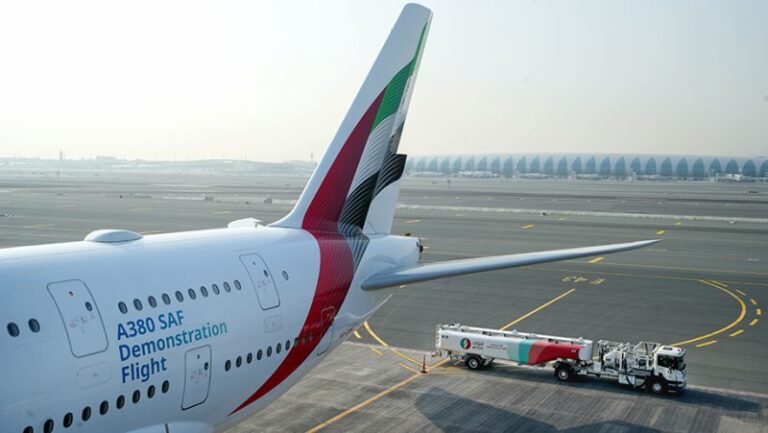On Wednesday, Emirates became the world’s first airline to operate an A380 demonstration flight using 100 per cent Sustainable Aviation Fuel (SAF).
The flight was operated from Dubai International (DXB) with one of its four engines powered on 100 per cent SAF.
That successful flight , Emirates says , helped demonstrate the potential of SAF “as a drop-in replacement that matches jet fuel’s technical and chemical requirements, while being a more sustainable alternative.”
This is the first time that drop-in SAF has been used on an A380 aircraft.
The 100 per cent SAF was used in one Engine Alliance GP7200 engine, while conventional jet fuel was used in the other three engines. The PW980 auxiliary power unit from Pratt & Whitney Canada also ran on 100 per cent SAF.
The flight carried four tonnes of SAF, comprised of HEFA-SPK provided by Neste (hydro processed esters and fatty acids synthetic paraffinic kerosene) and HDO-SAK from Virent (hydro deoxygenated synthetic aromatic kerosene).
ENOC secured the neat SAF comprised of HEFA-SPK, and blended it with Sustainable Aviation Kerosene (SAK) at its facility in Dubai International ahead of the demonstration.
Adel Al Redha, chief operating officer at Emirates Airline, said, “Emirates is the first passenger airline in the world to operate an A380 with 100 per cent drop-in SAF powering one of four Engine Alliance GP7200 engines. This is another proud moment for Emirates and our partners, as we put words into action with the research into and the trialling of higher concentrations of SAF to eventually lead to industry adoption of 100 per cent SAF flying.”
SAF is currently capped at a 50 per cent blend limit in engines for commercial flights.
“Seeing Emirates flying an A380, the world’s largest airliner, powered by an engine running on 100 per cent Sustainable Aviation Fuels is a symbolic moment. These fuels are the most effective way to address CO2 emissions in the aviation industry today. SAF is vital to meeting the sector’s target of net zero emissions in 2050, but needs the backing of the whole industry. At Airbus, we are working to make all our aircraft 100 per cent SAF-capable by 2030,” added Julie Kitcher, Airbus executive vice president Communications and Corporate Affairs.
Emirates implements measures to decarbonise operations
Earlier this year, Emirates completed the first 100 per cent SAF-powered demonstration flight in the region on a GE90-powered Boeing 777-300ER.
Subsequently, Shell Aviation reached an agreement with Emirates to supply the airline with more than 300,000 gallons of blended SAF for use at DXB. Last month, the first Emirates flight operating with that SAF took off from the airport.
Emirates also recently expanded its partnership with Neste for the supply of more than 3 million gallons of blended SAF in 2024 and 2025 for flights departing from Amsterdam Schiphol and Singapore Changi airports. The blended SAF will comprise over one million gallons of neat SAF. This represents a blended ratio of over 30 per cent neat SAF combined with conventional Jet A-1 fuel.



